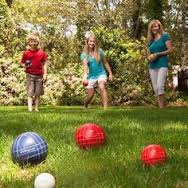STUMBLE-KICKING: Young children (ages 15-18 months) usually ‘stumble-kick’ a ball before performing a true kick. Stumble-kicking is essentially walking into a
ball and perhaps nudging it with their toes in order to move the ball forward.
KICKING A PLAYGROUND BALL: Swing-through
kicking a stationary ball typically occurs at 18-24 months. Pre-requisites
for true swing-kicking include the ability to stand alone, weight shift from
one leg to another, rotate at the trunk, and momentarily stand alone on one foot. I love to practice
kicking in a hallway. Rather than running after a wayward ball, the ball
stays ‘corralled’ within the corridor and can be easily retrieved.
If a child is having difficulty balancing, I might initially place them
in standing against a wall to assist with trunk support and prevent loss of
balance. This can give them initial success in kicking because they are not worried about falling.
 |
| Swing-Through Kicking Requires Standing on 1 Foot Momentarily |
 |
| Trunk Rotation is Necessary for a True Swing-Through Kick |
CATCHING A BALL: The typical age for catching a large ball is 24-26 months.
Many children develop a fear of catching a ball because they are afraid of getting hit in
the face by a ball. Balls come fast and they are hard! That is
why I love to teach the skill of catching by using a 12-15 inch inflated balloon. A tossed
balloon arrives more slowly and floats in front of the child, giving them a
slightly longer period of time to get their arms together to ‘trap’ it. It is soft, so if they are unsuccessful in
catching the balloon, they don’t get startled by a whack on the nose! Once a child is having 80% success rate with
catching a balloon, I might try a stuffed animal of about the same size. The
stuffed animal is heavier and moves faster, but it is soft and of an irregular
shape. This often leads to successful
catching, as the child is able to snag an arm, leg, or head of the stuffed
animal before it falls to the floor. When
your child has been successful catching balloons and stuffed animals you can
try a playground ball. If they don’t
have success, don’t force the issue. Let
them continue with the balloon or stuffed animal for a while longer.
Other ball games for older children:
Bocce is a great game to practice throwing. It is easy to learn and fun for every age.
Another great way to perfect ball skills and balance is bowling. There are lots of fun, inexpensive Bowling Sets that you can purchase or you can easily create a bowling set by using small boxes or stuffed animals and having children forward roll a small ball between their legs toward the "pins".
 |
Another great way to perfect ball skills and balance is bowling. There are lots of fun, inexpensive Bowling Sets that you can purchase or you can easily create a bowling set by using small boxes or stuffed animals and having children forward roll a small ball between their legs toward the "pins".
Remember that ball playing should
be fun! Don’t stress out if your child
isn’t able to catch the first time you try.
Mastery of ball skills will take years.
Make it a good time of family play and interaction and kids will love
practicing and will eventually be successful.
This Concludes our 3 Part Series of the Development of Early Ball Skills
Blog Administrator: Trisha Roberts
proeducationaltoys@gmail.com
Copyright © 2017 TNT Inspired Enterprise, LLC, All rights reserved.
Unauthorized duplication is a violation of applicable laws.





No comments:
Post a Comment